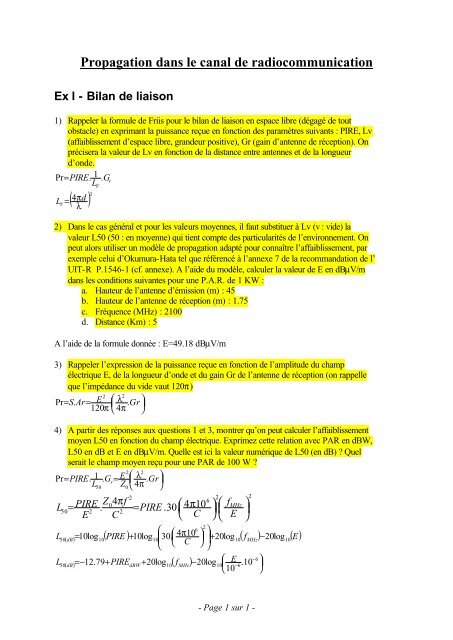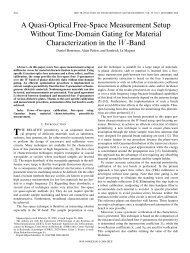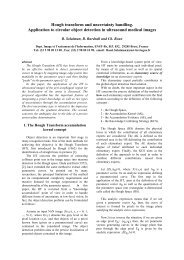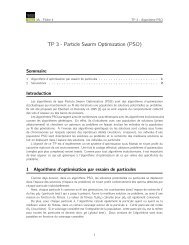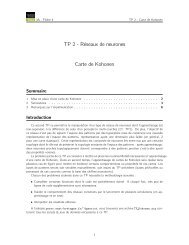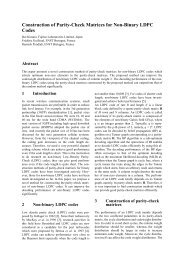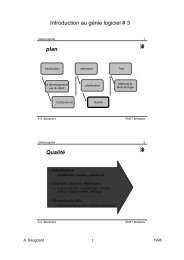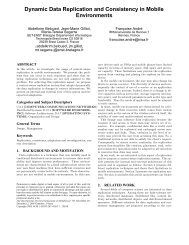Propagation dans le canal de radiocommunication - Ex I
Propagation dans le canal de radiocommunication - Ex I
Propagation dans le canal de radiocommunication - Ex I
You also want an ePaper? Increase the reach of your titles
YUMPU automatically turns print PDFs into web optimized ePapers that Google loves.
ISP 503 – 2004/2005 –<strong>Propagation</strong> CorrectionL50 µ+L50 log10L50 log10( dB) = −12 .79+PIREdBW+20log10( fMHz) −EdBV/m120( dB) = 107 .21+PIREdBW−EdBµ V/m+20 ( fMHz)( dB) = 107 .21+(PARdBW+2.15) −EdBµ V / m+20 ( fMHz)( dB) = 109 .36+PARdBW−EdBµ V / m+20 ( fMHz)L50 log10Ici, L50(dB)= 156.63 dBSi la PAR vaut 100 W, cela correspond à 20 dBW au lieu <strong>de</strong> 30 dBW, il suffit <strong>de</strong> retrancher10 à la va<strong>le</strong>ur du champ précé<strong>de</strong>nt en dBµV/m :E=49.18-10=39.18 dB µV/m5) Déterminer l’affaiblissement d’espace libre (en dB) <strong>dans</strong> notre situation et en déduirel’affaiblissement en excès Lex (en dB).LvdB=10.log10(Lv)=112.87 dB=> LexdB=L50(dB)-LvdB= 43.76 dB6) On désire prendre en compte <strong>le</strong>s variations du signal autour <strong>de</strong> la moyenne estimée par <strong>le</strong>modè<strong>le</strong>. On adopte une loi lognorma<strong>le</strong> pour <strong>le</strong>s variations <strong>le</strong>ntes du champs, d’écart typesupposé à 8 dB, et une loi <strong>de</strong> Ray<strong>le</strong>igh d’écart type 5 dB pour ses variations rapi<strong>de</strong>s .Pour chaque loi, quel<strong>le</strong> est la va<strong>le</strong>ur minima<strong>le</strong> du signal pour laquel<strong>le</strong> ses variationsresteront inférieures pendant 90% et 98% du temps ?On peut utiliser la fonction <strong>de</strong> répartition qui donne la probabilité pour que la variab<strong>le</strong>aléatoire, ici <strong>le</strong> signal, reste inférieure à l’abscisse indiquée.Pour la loi gaussienne centrée d’écart type unité :−0.461( x+0.582)21−F ( x)= 0.5e[ ]Pour la loi <strong>de</strong> Ray<strong>le</strong>igh d’écart type unité :F ( y)= 1−e⎛ 2 ⎞⎜y −⎟⎝ 2 ⎠On exprime x en fonction <strong>de</strong> F(x) :x =−0.582+ln[ 2*1 ( −F(x))]−0.461[ ( )], pour la loi gaussienney= −2*ln 1−Fy , pour la loi <strong>de</strong> Ray<strong>le</strong>ighOn en déduit pour <strong>le</strong>s va<strong>le</strong>urs normalisées :Gaussienne :x=1.3 @ 90%x=2.1 @ 98%Ray<strong>le</strong>igh :y=2.2 @ 90%y=2.8 @ 98%En dénormalisant et compte tenu <strong>de</strong>s écarts-type :Gaussienne X=x*8dB :X= 10.4 dB @ 90%X= 16.8 dB @ 98%Pour Ray<strong>le</strong>igh Y=y*5 dB :- Page 2 sur 2 -
ISP 503 – 2004/2005 –<strong>Propagation</strong> CorrectionY=11 dB @ 90%Y=14 dB @ 98 %7) Sachant que l’émetteur dispose d’une antenne d’émission sectoriel<strong>le</strong> avec un gain <strong>de</strong> 15dBi quasiment constant <strong>dans</strong> <strong>le</strong> secteur couvert, sachant que <strong>le</strong> récepteur a une sensibilité–117 dBm et dispose d’une antenne omnidirectionnel<strong>le</strong> <strong>de</strong> gain 2.1 dBi, quel<strong>le</strong> doit être lapuissance d’émission minima<strong>le</strong> pour que la puissance du signal reçu reste, pendant 90%ou 98% du temps, au <strong>de</strong>ssus du seuil <strong>de</strong> sensibilité du récepteur ? Comment peut-oncompléter ce bilan <strong>de</strong> liaison ?PrdBm=PedBm + GedB –[L50(dB) + X + Y] + GrdB =>=> PedBm = PrdBm-GedB-GrdB+L50(dB) + X + Y =-117-15-2.1+156.63 +11 +10.4= 43.85 dBm @ 90% -> 13.85 dBW (25 W)-117-15-2.1+156.63 + 16.8 + 14 = 53.33 dBm @ 98% -> 23.33 dBW (215 W)Il faudrait éga<strong>le</strong>ment prendre en compte <strong>le</strong>s pertes câb<strong>le</strong>s, <strong>le</strong>s pertes corps humain, <strong>le</strong>s pertesliées aux hydrométéores…<strong>Ex</strong> II - <strong>Propagation</strong> au-<strong>de</strong>ssus d’un plan d’eau <strong>de</strong> merf=900 MHzD= 20 kmOndulation δ = 50 cmh= 10 mD est la distance qui sépare <strong>le</strong>s <strong>de</strong>ux antennes, h <strong>le</strong>ur hauteur par rapport au sol, δ l’amplitu<strong>de</strong><strong>de</strong>s vagues.1) La polarisation du champ é<strong>le</strong>ctrique étant parallè<strong>le</strong> à la surface <strong>de</strong> l’eau, supposée trèsbonne conductrice, que vaut <strong>le</strong> coefficient <strong>de</strong> réf<strong>le</strong>xion ρ?On a pour <strong>le</strong> critère <strong>de</strong> Ray<strong>le</strong>igh :C = R4πδ sin( ψ)λDans cette expression, ψ est l’ang<strong>le</strong> entre <strong>le</strong> rayon inci<strong>de</strong>nt et <strong>le</strong> sol par rapport àl’horizonta<strong>le</strong>. Ici on a tan(ψ)=10/10.10 3 =0.001 ≈ sin(ψ).On trouve alors C R =1.89 %. PuisqueCR < 10%, la réf<strong>le</strong>xion peut-être considérée comme spéculaire => aucun terme <strong>de</strong> diffusionn’affaiblira la va<strong>le</strong>ur du coefficient <strong>de</strong> réf<strong>le</strong>xion <strong>de</strong> façon significative.On a par ail<strong>le</strong>urs un plan d’eau salée qu’on assimi<strong>le</strong> à un conducteur métallique parfait, <strong>le</strong>champ tangentiel s'annu<strong>le</strong>, donc <strong>le</strong> champ est réfléchi avec une intensité éga<strong>le</strong> mais uneorientation opposée à cel<strong>le</strong> du champ inci<strong>de</strong>nt. Il en résulte ρ=-1.2) Calcu<strong>le</strong>z <strong>le</strong> déphasage entre <strong>le</strong> trajet direct et <strong>le</strong> trajet réfléchi en fonction <strong>de</strong> h, λ et DR = D1- Page 3 sur 3 -
ISP 503 – 2004/2005 –<strong>Propagation</strong> CorrectionR2= 2⎛⎜⎝D22⎞⎟⎠+ h22h∆ R = R2− R1=D2π4πh∆Φ = ∆R=λ λD2= D22⎛ 2h⎞1+⎜ ⎟⎝ D ⎠⎡ 1 ⎛ 2h⎞≈ D⎢1+ ⎜ ⎟⎢⎣2 ⎝ D ⎠2⎤⎥⎥⎦3) <strong>le</strong>s antennes étant supposées omnidirectionnel<strong>le</strong>s, montrez que l'intensité du champ totalreçu est proportionnel<strong>le</strong> à ce déphasage.On néglige <strong>le</strong>s différences d'intensités pour <strong>le</strong>s champs provenant <strong>de</strong>s différents trajets− j∆ΦET= Ed+ Er= Ed+ Edρe, avec ρ=-1 (réf<strong>le</strong>xion spéculaire etpolarisation //), Ed=champ du trajet direct− j∆ΦE = E 1 − e = E 1 − cos ∆Φ + jsin∆ΦEET=dTE dT( )d( ) ( )22[ 1+cos ( ∆Φ) − 2cos( ∆Φ) + sin ( ∆Φ)]⎡1−cos4 ⎢⎣ 2( ∆Φ)( )⎤⎥ = 2E⎦⎛ ∆Φ ⎞sin ⎜ ⎟ ≈⎝ 2 ⎠= EddEd4) Calcu<strong>le</strong>r l’atténuation tota<strong>le</strong> L50(dB) et comparez-là aux résultats du cours. Commentpeut-on justifier ce résultat ?La puissance est proportionnel<strong>le</strong> au carré du champ et <strong>le</strong> champ total étant ici proportionnel auchamp <strong>de</strong> l'on<strong>de</strong> ayant suivie <strong>le</strong> trajet direct, la puissance tota<strong>le</strong> reçue est cel<strong>le</strong> obtenue <strong>dans</strong>2<strong>de</strong>s conditions d'espace libre, modulée par ∆Φ :P = SrPr⇒P∆Φ2( λ . ∆Φ)22 22E 2222TE ∆Φ PGe 2. A = . λdGr=. λeGr=⎛ 4 ⎞2∆Φ λ Gr=P = P λ⎜ × πhree⎟Z04π120π4π4π4πD4πDλD⎠e4⎛ h ⎞= ⎜ ⎟⎝ D ⎠D'où l'atténuation tota<strong>le</strong> en dB :⎛ h ⎞L dB = 40 log⎜⎟⎝ D ⎠4πDCela correspond à une évolution <strong>de</strong> –40 dB par déca<strong>de</strong> avec la distance entre <strong>le</strong>s antennes. Encours, nous avions noté qu’une tel<strong>le</strong> évolution était prévisib<strong>le</strong> lorsque l’ellipsoï<strong>de</strong> <strong>de</strong> Fresnelétait encombrée :⎝- Page 4 sur 4 -
ISP 503 – 2004/2005 –<strong>Propagation</strong> CorrectionQuel<strong>le</strong> est ici cette distance D pour laquel<strong>le</strong> <strong>le</strong> plan réf<strong>le</strong>cteur sera tangent au premierellipsoï<strong>de</strong> <strong>de</strong> Fresnel ? On a :( 2 )h=1 λDDhf ⇔ f =2λ2Dans notre cas, λ=1/3 et h=10 => D f =1200m, or D=20000 m ! Notre résultat est doncparfaitement conforme aux prévisions compte tenu du fait que nous sommes <strong>dans</strong> unesituation <strong>de</strong> réf<strong>le</strong>xion sur terre plate avec ellipsoï<strong>de</strong> <strong>de</strong> Fresnel encombrée.(Avec une hauteur <strong>de</strong>s antennes par rapport au sol h=41m, l’ellipsoï<strong>de</strong> resterait dégagée et laréception <strong>de</strong>vrait être nettement améliorée)- Page 5 sur 5 -
ISP 503 – 2004/2005 –<strong>Propagation</strong> CorrectionAnnexes :Fonctions <strong>de</strong> répartition log-norma<strong>le</strong> et Ray<strong>le</strong>igh :1−F(x)= 0.5e[ −0.461( x+0.582)]2F(y)= 1−e⎛2y ⎞⎜ −⎟⎝2⎠- Page 6 sur 6 -


